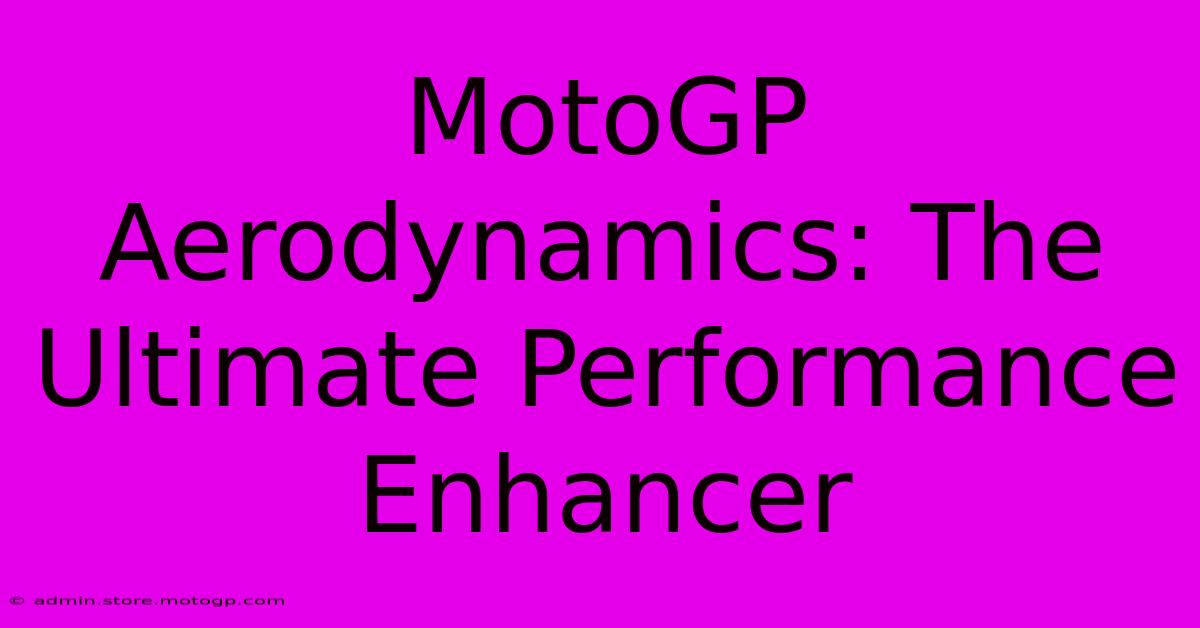MotoGP Aerodynamics: The Ultimate Performance Enhancer

Table of Contents
MotoGP Aerodynamics: The Ultimate Performance Enhancer
MotoGP, the pinnacle of motorcycle road racing, is a relentless pursuit of speed and performance. Every millisecond counts, and every advantage is fiercely contested. In this high-stakes environment, aerodynamics play a crucial, often underestimated, role in determining victory. This article delves into the complex world of MotoGP aerodynamics, exploring how these sophisticated designs enhance performance and the continuous evolution driving this critical area of motorcycle development.
Understanding the Aerodynamic Challenges
MotoGP bikes, traveling at speeds exceeding 200 mph (320 km/h), face immense aerodynamic forces. These forces, including drag and lift, significantly impact speed, stability, and cornering ability.
Drag: The Enemy of Speed
Drag is the resistance a bike encounters as it moves through the air. Reducing drag is paramount to achieving higher top speeds and improved acceleration. Every component, from the fairing to the rider's leathers, contributes to the overall drag coefficient.
Lift: A Threat to Stability
Lift, the upward force generated by the air flowing over the bike, can destabilize the machine at high speeds, especially during cornering. This is particularly critical in MotoGP, where riders are pushing the limits of grip and lean angles. Effective aerodynamic designs must minimize lift to maintain stability and control.
Aerodynamic Solutions in MotoGP
Manufacturers employ sophisticated aerodynamic solutions to combat drag and lift. These include:
Winglets and Aerodynamic Appendages:
These small, strategically placed wings generate downforce, pressing the bike to the track for improved stability and traction, particularly during acceleration and cornering. The design and placement of these winglets are constantly refined, with teams experimenting with different configurations to optimize performance in specific track conditions.
Fairings and Bodywork:
The fairing, the streamlined shell enveloping the engine and other components, is meticulously designed to minimize drag and manage airflow. Computational Fluid Dynamics (CFD) simulations and wind tunnel testing play a vital role in optimizing the fairing's shape and reducing turbulent air flow. Even small changes to the fairing's shape can dramatically affect performance.
Rider Position and Clothing:
The rider's position and the design of their leathers contribute significantly to the overall aerodynamic profile. Riders are often positioned in a tucked-in posture to minimize drag, and specialized suits are designed to be as aerodynamically efficient as possible.
Underbody Aerodynamics:
The area beneath the motorcycle is also crucial for aerodynamic performance. Underbody designs can be used to manage airflow, reducing drag and enhancing downforce. This is a less visible, but equally important aspect of MotoGP aerodynamics.
The Constant Evolution of MotoGP Aerodynamics
The pursuit of aerodynamic perfection is a continuous process. Teams constantly refine their designs, experimenting with new materials and configurations to gain even the slightest advantage. Regulations often play a role in shaping the direction of development, with governing bodies imposing restrictions to limit performance gains and ensure safety.
The Role of Technology:
Advanced technologies, such as CFD simulations and wind tunnel testing, play a crucial role in the development of aerodynamic solutions. These technologies allow engineers to test different designs virtually, reducing the time and cost associated with physical prototyping.
The Human Factor:
Despite the technological advancements, the human element remains crucial. Experienced engineers and technicians interpret the data, making crucial design decisions based on their expertise and understanding of track conditions.
Conclusion: The Winning Edge
In the fiercely competitive world of MotoGP, even small aerodynamic improvements can translate into significant performance gains. The relentless pursuit of aerodynamic perfection is a testament to the dedication and ingenuity of the teams and engineers involved. The ongoing development of aerodynamic solutions continues to push the boundaries of motorcycle technology, delivering thrilling racing and breathtaking speeds. The aerodynamic battle on the track is as captivating as the race itself, a constant evolution shaped by innovation and competition.

Thank you for visiting our website wich cover about MotoGP Aerodynamics: The Ultimate Performance Enhancer. We hope the information provided has been useful to you. Feel free to contact us if you have any questions or need further assistance. See you next time and dont miss to bookmark.
Featured Posts
-
Rev Up Your Engines Moto Gp Arcade Game Is Here
Feb 20, 2025
-
Circuit Of The Americas Celebrate The Thrill Of The Race
Feb 20, 2025
-
Cota Parking The Smart Fans Guide
Feb 20, 2025
-
The Sting F1 Performance Unleashed
Feb 20, 2025
-
F1 Grid Analysis Predicting Race Day Outcomes
Feb 20, 2025
